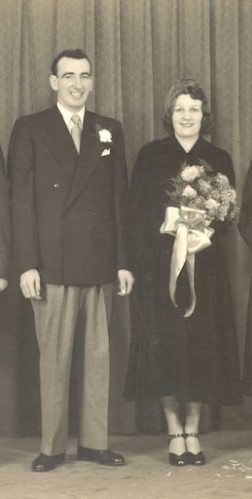#98 UNCLE STEPHEN'S HORRENDOUS ACCIDENT
My
husband is the fourth generation of Stephen Whelans. He shares this name with
his uncle and godfather Stephen Whelan (1926-1950), his grandfather Stephen
Whelan (1881-1926), and his great-grandfather Stephen Whelan (1825-1906).
STEPHEN WHELAN III
Stephen, the youngest of the Whelan clan, was born November 2, 1926, sadly four months after his father Stephen’s tragic death. His older brother, Lorne, stepped in as Stephen’s father figure.
In his late teens, Stephen went west—to Alberta and the North West Territories and to Vancouver Island, perhaps looking for work in the mill towns.
By 1949, Stephen was back in Pembroke, applying for work at Deep River. A letter of reference for Stephen written by a James J.McCann, Ottawa read: “I have very much pleasure in stating that I have known this young man most of his life, and I believe him to be honest, of good character and in general good standing morally amongst his acquaintances. I cannot say much with regard to his capabilities in any particular position but I do think that if given employment, he would do his utmost to discharge successfully any duties which he might undertake.” Stephen was hired.
Stephen, aged 23, married Rita Shea, 30, in St.Columba’s Cathedral, Pembroke on Monday, December 26, 1949 at 9 am. “Red roses and chrysanthemums were used to decorate the altar…A wedding breakfast was served at the home of the bride’s mother.” Daughter Kathleen was born the next year.
Stephen was employed at the Chalk River Laboratories in Deep River, about 180 km north-west of Ottawa, 50 km northwest of Pembroke. Established in 1944, CRL was a site of significant research and development to support and advance nuclear technology, particularly CANDU reactor technology. In 1952, Atomic Energy of Canada Limited, created by the Canadian government to promote the peaceful use of nuclear energy took over operation of Chalk River. AECL operated nuclear research reactors to produce nuclear material for medical and scientific applications. At one point, Chalk River Labs produced about 1/3 of the world’s medical isotopes (used in imaging procedures like PET scans to visualize organs and tissues allowing for early detection of diseases. Some isotopes are used in targeted radiation to kill cancer cells and alleviate symptoms of certain conditions.) Despite its declaration of peaceful use, Chalk River did supply the USA with plutonium, in the form of spent reactor fuel, to be used in the production of nuclear weapons.
On December 14, 1950, Stephen and four others were the only men working at the pilot plant. Stephen had been called in at the last minute to replace a colleague. He was working, at the tail end of the separation plant, with the evaporator that reduced the volume of liquid waste by dissolving uranium rods in ammonium nitrate. Unfortunately, the process had concentrated about 90 kilograms of ammonium nitrate and it detonated. At about 1:30 p.m., there was an explosion in the chemical storage area. One worker at the plant in a nearby building said the explosion was strong enough to rattle buildings in all close structures; he said that he saw a smokestack-like object going up in the air, followed by a puff of smoke. Some radiation resulted from the explosion, but officials said it was confined to the storage area with no danger of spreading and there was no significant radiation hazard. The blast occurred some distance from the reactor which was not damaged and was some distance away from the atomic pile.
The caved-in
roof of the 30x30’ chemical storage area buried Stephen in a pile of rubble.
His head was badly crushed and his back and arms broken; he died en route to hospital.
His brother, Lorne, was called in to identify Stephen’s body that had been placed
in a lead casket to contain radioactivity. ’Four other men were injured in the
blast and they suffered from shock and cuts from the flying pieces of metal.
Stephen was just 24 years old at the time of this accident. He is buried in St. Columba’s Cemetery , Pembroke.
St. Columba's Cemetery, PembrokeThe AECL did not want the public to know about plant operations especially involving radioactive materials. Workers were sworn to secrecy and people were not supposed to know what was going on as it was just after the war.
Rita and Stephen had been married less than a year and they had a two month old daughter.
Rita was not told the truth about the accident—she was lied to-- and for years she worried that Stephen had somehow caused the accident. (not so!) Rita received only a $100 settlement, plus workmen’s compensation. After Stephen’s death, Rita and Kathleen lived in a one-bedroom apartment close to downtown Pembroke. Rita was a nurse, but could not practice or she would have lost her husband’s Workmen’s Compensation.
In 1956, Rita married Edward “Ted Woollam (1914-2003) and they had two children—Sara and Paul. Rita was grandmother to Sabrina Shannon (my blog# 39 Sabrina’s Law).
AEC bragged that it had a 50 year history of no fatalities. In 2009, members of the Canadian Nuclear Society visited Rita in her home, explained the accident, assured her that Stephen was no way at fault, and that this accident would not be hidden away.
article posted at https://nuclearheritage.com/a-young-life-lost-too-soon/
Rita passed
September 23, 2017, aged 99, and her ashes are interred in the St.Columba’s
Cemetery.
Stephen Whelan b. Nov 2, 1926 in Admaston Township, Renfrew Co m. Rita Mary Shea (1919-2017) on Dec 26, 1949 in Pembroke, Ont d. Dec 13, 1950 in Chalk River, Ont (Steve's uncle and godfather)











So tragic. Also am disgusted that the company did not assume more responsibility and support for the family. A tragic life and very difficult times.
ReplyDeleteSo very sad! The coverup was outrageous!
ReplyDelete